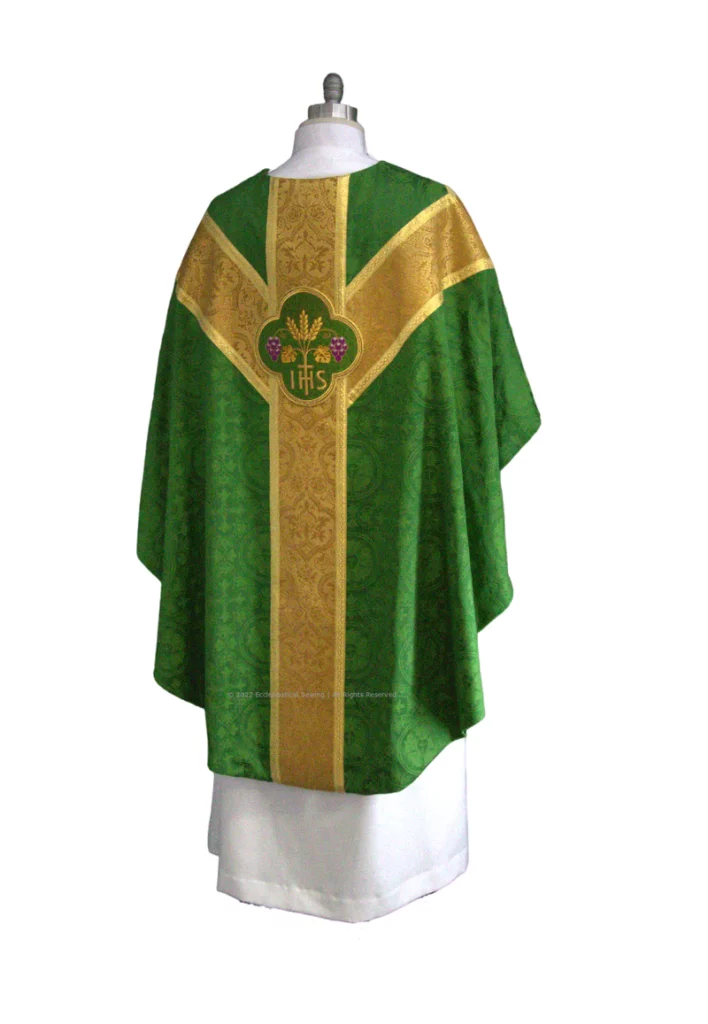A discussion about Chasubles
Many of us in more Protestant parts of the country see our pastors in only a stole over his cassock or alb. When I came out of the small town Mid-West, country church world, and started seeing Protestant pastors wearing the same “outfits” as the Roman Catholics, I immediately had to learn why. That was many years ago, and I have since corrected my ignorance and terminology of proper liturgical wear. If you’re a member of some denominations, chances are that the priest or pastor wears a large vestment over his alb or robe and stole. This is called a “chasuble,” and it has a long history. So, what is the symbolism of a chasuble? What types of this vestment are still in use today?
History of the Chasuble
It is well known by historians that the origins of the chasuble go back to the Roman empire. Originally, Romans of the lower classes wore a cloak made of a single piece of cloth, which was fastened in the front. Alternately, it was sometimes seamed down the front. This cloth had a hole for the head and was essentially round or conical. Romans called this piece of clothing a “clasura,” or “little house.”
In those days, the chasuble was an ordinary garment, and very full in form. The idea was that the cloth would cover the wearer’s clothes, providing extra warmth and protection from the elements. By the third century, chasubles were becoming more of a Christian symbol. Part of this was due to the people who wore chasubles more often: women, laborers, and people who were traveling.
Later on, the chasuble became obsolete as ordinary clothing. More modern clothing became available. However, by this time the use of a chasuble in the liturgy was ubiquitous. Originally, liturgies were celebrated in ordinary clothes, though as time went on a nicer set would’ve been used by the priests and deacons out of respect. Eventually, this garment evolved into a liturgical vestment that became specific to priests and used only during celebrations of the Mass.
In Roman Catholic usage, the chasuble has come to symbolize the Yoke of Christ. After all, Catholics believe that the priest stands in the person of Christ, exercising his office of priest. Lutherans originally rejected the chasuble, but they’ve returned. Anglicans also abolished chasubles in the Reformation, but have resumed using them since the 18th century liturgical renewal.
Types of Chasuble
Although rare, the original form of chasuble, known now as a conical chasuble, can be seen occasionally. These are generally inconvenient to wear because they don’t offer much freedom of arm movement. If you want a modern description, they’re basically like a circular poncho. Over time, the chasuble became smaller. Most church supply houses, including Ecclesiastical Sewing, offer three basic types of chasuble: the Monastic, the Gothic or Regular, and the Fiddleback. Here is a description of each:
Monastic chasubles: These are the largest and fullest-fitting chasubles in modern use. They are essentially elongated ovals, with the side of the chasuble normally falling at about the wearer’s wrist. Some models are rectangles instead, but with the same basic dimensions. Orphreys tend to be the “column” style on both front and back: A single band going from neck to hem.
Gothic or Regular chasubles: Gothic chasubles tend to be a more elongated oval shape than the monastic, and never have squared-off corners. The sides tend to reach to the wearer’s elbow or a little bit lower, but not to the wrist. Orphreys tend to be a column band in the front, with the “Y” shaped cross in the back. Other than traditional Catholic churches, these are the most common.
Fiddleback chasubles: This type of chasuble is also called the “Roman” chasuble. These barely cover the shoulders on the side and hang down in the front and back. Often richly decorated, they are most common in Traditionalist Catholic congregations.
I hope you will contact me with any questions concerning chasubles. They are one of my favorite things to make. I also have the option for you to make them yourself, and I promise–if you can read a pattern and sew–they are one of the easier items to construct!
Let me help you be part of history and learn to make these beautiful garments for your pastor or priest!
~Soli Deo Gloria~
Sources:
“Styles and Tradition in the Chasuble of the Roman Rite.” RORATE CAELI. Accessed March 28, 2020. https://rorate-caeli.blogspot.com/2008/02/styles-and-tradition-in-chasuble-of.html.
“Chasuble.” CATHOLIC ENCYCLOPEDIA: Chasuble. Accessed March 28, 2020. http://www.newadvent.org/cathen/03639a.htm.
“Do You Know What Is The Significance Of The Vestments Priests Wear?” Harcourts, March 20, 2020. https://harcourts.com/blog/what-is-the-significance-of-the-vestments-priests-wear/.
Kosloski, Philip. “Why Do Priests Wear a Chasuble at Mass? And What’s a Chasuble?” Aleteia. Aleteia, June 19, 2017. https://aleteia.org/2017/06/19/why-do-priests-wear-a-chasuble-at-mass-and-whats-a-chasuble/.
Tribe, Shawn. “Sacristy Tips: How To Correctly Wear a Conical Chasuble.” Liturgical Arts Journal, April 23, 2018. https://www.liturgicalartsjournal.com/2018/04/sacristy-tips-how-to-correctly-wear.html.
“What Are The Different Types Of Chasubles?” Churchgoers. Accessed March 28, 2020. https://www.churchgoers.com/blogs/chasubles/what-are-the-different-types-of-chasubles.
“Why Do Priests Wear a Chasuble? – Our Lady of Joy Roman Catholic Church, Carefree, AZ.” http://dev.oloj.org.php56-26.ord1-1.websitetestlink.com. Accessed March 28, 2020. https://www.oloj.org/blog.php?month=201607&id=1610346698&cat=233704823&pg=1&title=Why+do+priests+wear+a+chasuble?.
Rose Chasuble and Stole Vestments for Advent and Lent
What Vestments Does a Priest or Pastor Need?

